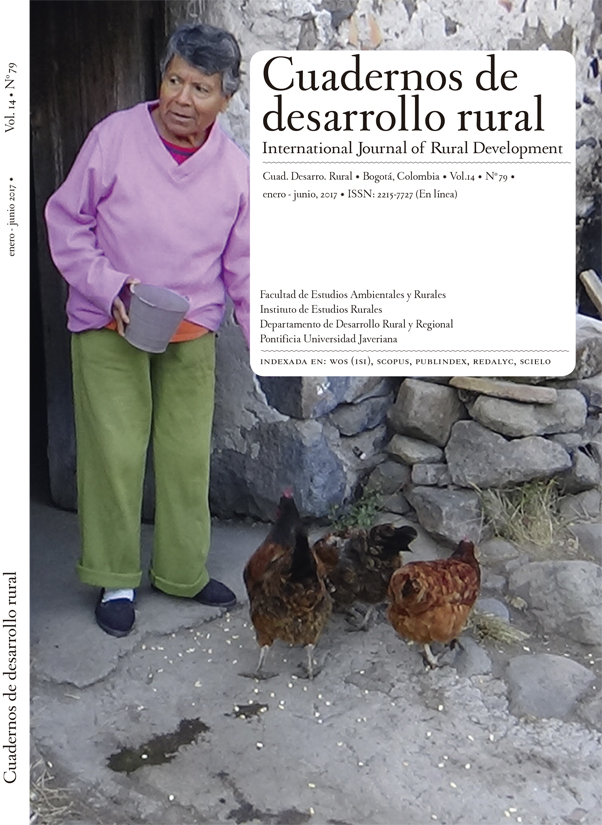Resumo
Producer-consumer linkages in a small rural market in Mexico are studied. Two short food supply chains were identified, which reduce producer-consumer distance and enable the exchange of information regarding egg origin and farming practices. This allowed the creation of food symbolism, increased consumers knowledge and trust on producer and their products. Producers increased knowledge regarding egg characteristics demanded and ways to satisfy such demand. It is concluded that small-scale egg producers are able to sale highly valued eggs by their tangible/intangible attributes, allowing closeness, confidence, food symbolism and exchange of information with consumers.
Aubry, C., & Kebir, L. (2013). Shortening food supply chains: A mean for maintaining agriculture close to urban areas? The case of the French metropolitan area of paris. Food Policy, 41, 85-93.
Ayim, M., & Akonor, P. (2014). Egg consumption: Patterns, preferences and perceptions among consumers in ACCRA metropolitan area. International Food Research Journal, 21(4), 1457-1463.
Brambila, J. (2011). Bioeconomía: Conceptos y fundamentos. México: COLPOS.
Caccia, S. (2012). Short circuits of production and consumption. In D. Danilo (Ed.), Inside a champion. An analysis of the Brazilian development model (pp. 172-181) Heinrich Boll Foundation.
Centeno, S. B., López, C. A., & Juárez, M. A. (2007). Producción avícola familiar en una comunidad del municipio de Ixtacamaxtitlán, puebla. Técnica Pecuaria México, 45(1), 41-60.
Espeitx, E. (1996). Los nuevos consumidores o las nuevas relaciones entre campo y ciudad a través de los productos de la tierra. Agricultura y Sociedad, (80), 83-116.
Fischler, C. (1988). Food, self and identity. Social Science Information, 27(2), 275-292.
Goodman, D., & Watts, M. (1997). Globalizing food. Agrarian questions and global restructuring. London: Routledge.
Hinrichs, C. (2000). Embeddedness and local food systems: Notes on two types of direct agricultural market. Journal of Rural Studies, 16, 295-303.
Holloway, L., Kneafsey, M., Venn, L., Cox, R., Dowler, E., & Tuomainen, H. (2007). Possible food economies: A methodological framework for exploring food production-consumption relationships. Sociologia Ruralis, 47(1), 1-19.
Jeréz, M., González, A., Herrera, J., Vásquez, M., Segura, J., & Villegas, Y. (2009). Mercadeo de huevos de gallinas criollas (Gallus gallus L.) en los valles centrales de Oaxaca, México. Etnobiología, 7, 86-93.
Kneen, B. (1995). From land to mouth. Understanding the food system (NC Press Limited ed.). Canada.
LEADER. (2017). Marketing local products: Short and long distribution channels. rural innovation archive. Retrieved from http://ec.europa.eu/agriculture/rur/leader2/rural-en/biblio/circuits/contents.htm
Marsden, T., Banks, J., & Bistrow, G. (2000). Food supply chain approaches: Exploring their role in rural development. Sociologia Ruralis, 40, 424-438.
Murdoch, J., & Miele, M. (1999). "Back to nature": Changing "worlds of production" in the food sector. Sociologia Ruralis, 39(4), 465-483.
Pearson, D., & Henryks, J. (2011). Local food: Understanding consumer motivations in innovative retail formats. British Food Journal, 113(7), 886-899.
Pratt, J. (2007). The local and the authentic. Critique of Anthropology, 27(3), 285-300.
Renting, H., Marsden, T., & Banks, J. (2003). Understanding alternative food networks: Exploring the role of short food supply chains in rural development. Environment and Planning A, 35, 393-411.
Santini, F., & Gomez, S. (2013). Short food supply chains and local food systems in the EU. A state of play of their socio-economic characteristics. España: JRC Scientific and Policy Reports.
Senbeta, E., Zekele, N., & Molla, Y. (2015). Attitudes and perceptions of consumers to chicken Eggs. Attributes in eastern Ethiopia. Journal of Animal Production Advances, 5(6), 705-710.
Smith, K., Lawrence, G., MacMahon, A., & Muller, J. (2016). The resilience of long and short food chains: A case study of flooding in Queensland, Australia. Agriculture and Human Values, 33, 45-60.
Verhaegen, I., & Van Huylenbroeck, G. (2001). Costs and benefits for farmers participating in innovative marketing channels for quality food products. Journal of Rural Studies, 17, 443-456.
Weatherell, C., Tregear, A., & Allinson, J. (2003). In search of the concerned consumer: UK public perceptions of food, farming and buying local. Journal of Rural Studies, 19, 233-244.
Zaragoza, L., Martínez, B., Rodríguez, V., Hernández, J., Rodríguez, G., & Perezgrovas, R. (2011). Avicultura familiar en comunidades indígenas de Chiapas, México. Actas Iberoamericanas de Conservación Animal, 1, 411-415.
Propriedade intelectual:
Instituto de Estudios Rurales, Facultad de Estudios Ambientales y Rurales, Pontificia Universidad Javeriana, Bogotá, Colombia.
O envio de um artigo para a revista Cuadernos de Desarrollo Rural, indica que o(s) autor(es) certifica(m) e aceita(m):
- Que ele não tem sido publicado, nem aceito para publicação em outra revista.
- Que, no caso de sua publicação for aceita, se o artigo ter uma versão previa como working paper (literatura cinza) ou aparecer numa site da internet, deverá ser retirado dele, ficando somente o título, resumo, palavras-chave e hipervinculo à revista.
- Que uma vez publicado em Cuadernos de Desarrollo Rural não será publicado em outra revista.
Ao enviar artigos para avaliação, o(s) autor(es) aceita(m) transferir(em) os direitos de autor à revista Cuadernos de Desarrollo Rural, para os efeitos da sua publicação na versão impressa ou eletrônica, mesmo firmará a licença de uso parcial anexa.
Responsabilidade de conteúdos:
O conteúdo dos artigos publicados por Cuadernos de Desarrollo Rural é de exclusiva responsabilidade do(s) autor(es) e não necessariamente reflete o pensamento do comitê editorial e científico da revista Cuadernos de Desarrollo Rural. Os textos podem se reproduzir total ou parcialmente, mas citando a fonte.
A publicação opera de acordo com a Creative Commons Attribution License (CC), "Alguns direitos reservados". Para as licenças CC, o princípio é o da liberdade criativa. Este sistema não se opõe aos direitos autorais, mas complementa-se com eles. Somos conscientes da importância dos direitos de autor na nossa cultura.
Creative Commons oferece um sistema que automatiza a pesquisa de conteúdos "comuns" ou sob licença CC. Assim, ao licenciar o seu trabalho, o criador estabelece as condições gerais que são digitalmente incorporadas nele, para que um motor de busca possa identificá-las e escolher a mais conveniente.
This work is licensed under a Creative Commons Attribution-NonCommercial-ShareAlike 3.0 Unported License.



